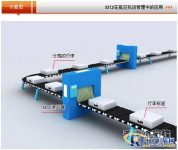
The Application of RFID Technology in Airline Baggage Consignment Management
[ad_1]
I. Overview
Utilize radio frequency identification system (RFID) To strengthen the tracking, distribution and transmission of baggage and improve safety management to avoid the occurrence of misdelivery. By attaching RFID electronic tags to each piece of luggage, the RFID electronic tags record various information about the aircraft passengers, such as flight number, parking position, departure time and other information. This is the beginning of the flow of each control node, such as the sorting, loading area, baggage claim area installed electronic tag reading and writing equipment, and then transmitted to each department, baggage information is shared and monitored in the entire transportation process, which improves its With the management level and efficiency, the luggage will be delivered to the destination on time and accurately.

2. Background
For the aviation industry, millions of passengers and checked luggage are handled every day and delivered to their destinations safely and on time. The global aviation business will pay as much as two or three billion U.S. dollars for lost and delayed baggage in a certain year. Moreover, in the entire process of baggage check-in, there are too many manual operations, so the accuracy cannot be guaranteed. At the same time, it is inevitable that there will be common problems such as wrong transportation and loss. The accuracy of baggage check affects the satisfaction of passengers. After arriving at the port, passengers find that their luggage does not arrive randomly, which affects the passenger’s journey and causes passengers to complain. To implement the operational responsibilities of checked baggage, passengers’ checked baggage needs to go through multiple links across regions. Without effective monitoring methods, it is impossible to monitor the entire transportation process, and it is impossible to distinguish responsibilities when the baggage is damaged or lost.
Three, system architecture
Paste on the baggage checked by airplane passengers randomlyRFIDElectronic tags, which record passenger personal information, port of departure, port of arrival, flight number, parking space, departure time and other information; electronic tag readers are installed on various control nodes of baggage flow, such as sorting, loading area, and baggage claim Writing equipment. When the baggage with tag information passes through each node, the RFID reader will read the information and send it to the database. Baggage information is shared and monitored throughout the entire transportation process.





Four, functions and advantages
(1) Efficient data collection Traditional data collection generally still remains in manual recording and simple computer management.andRFIDThe reader sends out a certain frequency radio frequency signal through the antenna. When the tag enters the magnetic field, it generates an induced current to obtain energy, sends out its own code and other information, which is read and decoded by the reader and sent to the host computer for relevant processing.RFID tags can be read by RFID reader, multiple tags can be read, the distance can be accurate to a few meters, for efficient data collection
(2) Strengthen safety and reliability. RFID technology can automatically identify target objects through radio frequency signals. Even multiple high-speed moving luggage objects can be identified at the same time, without manual intervention, and the operation is quick and convenient. The mechanization rate of the new RFID technology can reach more than 95%. This means that technically it will greatly reduce the possibility of baggage loss, late delivery, and wrong delivery. At the same time, RFID can work in a variety of harsh environments. This can enhance the safety of passengers’ luggage, greatly reduce their error rate and other problems, and enhance their satisfaction.
(3) Separate powers and responsibilities RFIDThe communication between the tag and the reader allows each link of operation to have traces to follow, and the responsibility of each link of operation and the operator is implemented. When some problems occur, when they are lost or shipped wrongly, they can accurately find out the related responsibilities. people.
(4) Real-time tracking and monitoring. Each RFID reader can be connected to the server through the network, and it can effectively record, track and monitor from all aspects of baggage check-in to the passengers’ hands. To grasp the entire process in time and conduct dynamic management. The management personnel can fully based on the statistical data and view the situation of each link, and can be managed in a targeted manner. Achieve a real-time information transmission and management.
(5) Secondary investment to reduce the total cost of ownership can benefit in many ways and for a long time. If the air consignment loses luggage or other problems due to management and errors, the loss is self-evident, and it will be a lot of trouble for the airline and related personnel.Compared to business pairsRFIDThe investment cost of the company is not high. If there is a problem, it will not only incur huge losses to the interests of the company, but also damage the image of the brand. And this kind of investment can not only be effectively managed, but can also raise a level from the overall information management, establish a brand image, and maximize benefits.
[ad_2]



